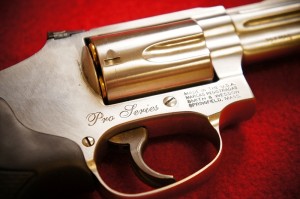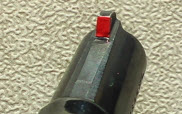Written by Greg Ellifritz
Caleb Giddings wrote two thought provoking blog posts last week about what he thought were mandatory requirements in a modern defensive revolver. Before reading further, check them out HERE and HERE
Caleb’s articles were insightful and provide a lot of guidance for people who carry revolvers for self defense. I don’t agree with all of his recommendations, however. For what it’s worth, I’ve been carrying a defensive revolver for a long time. I got my first revolver (a Smith and Wesson model 17 .22lr) when I was 10. I followed that up with a beat up Colt Official Police .38 when I was 12. I started carrying defensively when I was in college and had to make late night bank deposits for the gym I managed. That old Colt .38 was often on my hip.
When I became a cop, I resisted buying a semi-auto for quite a while. I liked my revolvers and was good with them. Who needs an autopistol? I carried a S&W Model 19 in an IWB holster as my off duty gun for almost two years! I still carry a revolver almost every day as a backup gun. I’ve learned a few things after carrying them for over 20 years.
Let’s go through Caleb’s list of “must have” items and I’ll provide you with my thoughts on the topic….
It must be comfortable to shoot with defensive .38 Special ammo- Comfort and recoil sensitivity are very sunjective feelings. What is comfortable to me may not be comfortable to others. I carry a S&W 342. It has a titanium frame and is one of the lightest .38 snubs available. I can shoot about 150 rounds through it before it becomes “uncomfortable” and I want to stop shooting. Unfortunately, many people who carry .38 snubs won’t shoot that many rounds in the gun’s entire life. If you aren’t shooting it much, it doesn’t really have to be “comfortable.”
Caleb draws a distinction in the two articles between the “modern defensive revolver” and the “compact defensive revolver.” I don’t think that distinction is made by most people who carry .38 snubs. They carry the snub because it is light and concealable, not because they want to be able to shoot 500 rounds in a day with it.
For most people, the airweight guns are the best compromise. They aren’t as comfortable to shoot as the all steel guns, but are about a half pound lighter. A skilled shooter will have no problems at all shooting an airweight revolver for 50-100 rounds if he has good grips.
It must have good sights. While I think snubs _should_ have good sights, this requirement is a tough one to actually meet. The 642 that Caleb recommends has a milled (not pinned) front sight. It can’t be easily changed. If you want good sights on a snub, you are going to have to pay for one of the more expensive versions or modify the sights yourself like my friend Claude Werner suggests in this article.
It must have a laser. I really disagree with this one. While I like lasers (and have a laser on one of my snub carry guns), I don’t think they are mandatory. The advantage of the laser is that it will help you shooting when you are in a goofy position and can’t get the gun up into your focal plane. That’s useful, but not a requirement.
Many people who purchase snubs do so because they don’t have a lot of money. A laser may be cost prohibitive for those folks. I’d rather see them with a gun they can afford without a laser than to be unarmed because they can’t afford a pair of crimson trace laser grips.
It must be DAO with a bobbed hammer- That is a useful feature, but not a requirement. I train to exclusively use double action defensively, but there isn’t much of a downside to having a single action notch. It may prove to be an issue in court, but we can provide expert testimony to counter any false allegations that you cocked the gun and had an unintentional discharge in a gunfight. The bobbed hammer does make for smoother and more comfortable carry however. Like I said…useful, but not absolutely necessary.
It must have a good trigger- I agree with this one 100%. Heavy double action triggers are the primary reason most folks find the .38 snub to be “inaccurate.” Especially with the Smith and Wesson guns, changing trigger springs is an easy fix. My only caution is to test your carry ammo thoroughly after you install your new springs. Sometimes the springs are too light to reliably ignite your primers.
It should not require moonclips to function- Agreed. Nothing more needs to be said about this one.
It must be chambered in a caliber for which modern defensive ammo is available- What caliber is that? Ammo is hard to find in any caliber right now! I don’t get too worked up about ammo for a .38 snub. Even the best modern defensive ammo fails miserably against the FBI’s four-layer denim test. There just isn’t enough velocity to make those rounds expand when they get plugged with clothing. Pick a caliber and cartridge that you shoot well…even if it’s .22 long rifle! A .22, .32, .327. .38. or .357 will all work well if you do your job.
All of Caleb’s suggestions are very nice to have on a defensive revolver. If you have the money and the desire, go for it. You’ll end up with a great shooting gun. But if you are stuck with a bone stock Smith and Wesson model 37 airweight, you will still be able to do some good work.
Take a look at the great gunfighters of the modern era. “Fitz” Fitzgerald, Rex Applegate, Bill Jordan, “Jelly” Bryce, and Charlie Askins all used snubs that wouldn’t pass this test…and somehow they did just fine.



